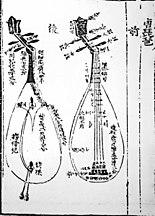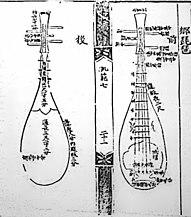The bipa is a pear-shape lute that is a traditional Korean musical instrument which is originated from Chinese pipa. There are also same instruments such as the Vietnamese đàn tỳ bà and the Japanese biwa.
| Bipa | |
| Hangul | 비파 |
|---|---|
| Hanja | 琵琶 |
| Revised Romanization | bipa |
| McCune–Reischauer | pip'a |
In the past, there were two types of bipa: the hyang-bipa (향비파 / 鄕琵琶) and the dang-bipa (당비파 / 唐琵琶). The former was native to Korea while the latter was imported from Tang dynasty.
The bipa fell out of use in the early 20th century. Attempts to revive it initially failed in 1988/89 due to fact that there are no existing professional players [1] but recently was successful. The recreation uses the existing modern Chinese pipa as a basis and the two modern bipa types were constructed almost exactly like pipa but modified to the Korean form, even with the use of fake nails and techniques. The difference is in the reintroduction of the two soundholes on the front. As well as this, the other type uses five strings. The strings used are of nylon, rather than the metal-nylon used for the Chinese pipa.
A version of the hyangbipa is also used that follow more closely to the original lines, not made like Chinese pipa, using silk strings and being plucked with bare fingers or with a stick. This is used for more traditional music and sanjo.
External links
- Traditional Korean Music with pictures and descriptions of bipa
Notes
- ^ Professor Lee Sung-chun (1936 - 2003) made an attempt in 1989


.jpg)